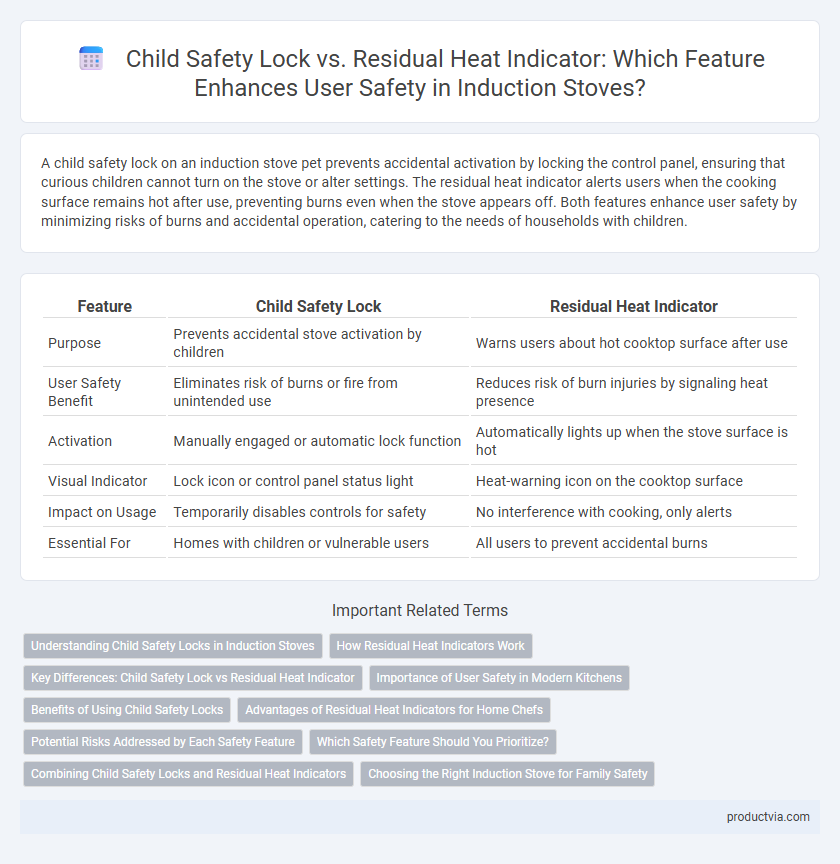A child safety lock on an induction stove pet prevents accidental activation by locking the control panel, ensuring that curious children cannot turn on the stove or alter settings. The residual heat indicator alerts users when the cooking surface remains hot after use, preventing burns even when the stove appears off. Both features enhance user safety by minimizing risks of burns and accidental operation, catering to the needs of households with children.
Table of Comparison
| Feature | Child Safety Lock | Residual Heat Indicator |
|---|---|---|
| Purpose | Prevents accidental stove activation by children | Warns users about hot cooktop surface after use |
| User Safety Benefit | Eliminates risk of burns or fire from unintended use | Reduces risk of burn injuries by signaling heat presence |
| Activation | Manually engaged or automatic lock function | Automatically lights up when the stove surface is hot |
| Visual Indicator | Lock icon or control panel status light | Heat-warning icon on the cooktop surface |
| Impact on Usage | Temporarily disables controls for safety | No interference with cooking, only alerts |
| Essential For | Homes with children or vulnerable users | All users to prevent accidental burns |
Understanding Child Safety Locks in Induction Stoves
Child safety locks in induction stoves prevent accidental activation by disabling the control panel, ensuring that children cannot turn on the appliance or change settings without supervision. Unlike residual heat indicators that alert users to still-hot surfaces, child safety locks actively block unauthorized operation, reducing risks of burns and injuries. Understanding the function and importance of child safety locks is crucial for parents seeking to create a safer cooking environment in homes with young children.
How Residual Heat Indicators Work
Residual heat indicators enhance user safety on induction stoves by signaling when the cooking zones remain hot after use, preventing accidental burns. These indicators utilize temperature sensors embedded beneath the glass surface to detect heat levels, activating visual alerts such as illuminated symbols or lights. Unlike child safety locks that restrict stove operation, residual heat indicators provide real-time feedback on surface temperature, allowing users to avoid contact with potentially dangerous hot areas.
Key Differences: Child Safety Lock vs Residual Heat Indicator
The child safety lock on induction stoves prevents accidental activation by disabling the control panel, ensuring that children cannot turn on the appliance or change settings unintentionally. The residual heat indicator alerts users to hot cooking zones after the stove is turned off, reducing the risk of burns by signaling that the surface remains hot. Key differences lie in their functions: the child safety lock is a preventative control feature for user access, while the residual heat indicator provides a post-use safety alert about surface temperature.
Importance of User Safety in Modern Kitchens
Child safety locks on induction stoves prevent accidental activation, significantly reducing the risk of burns or kitchen accidents involving children. Residual heat indicators warn users when the cooking surface remains hot after use, minimizing the chances of accidental contact and injuries. Both features are critical in modern kitchens to enhance user safety and ensure a secure cooking environment.
Benefits of Using Child Safety Locks
Child safety locks on induction stoves prevent accidental activation by children, significantly reducing the risk of burns and kitchen accidents. These locks ensure the stove remains off during cleaning or when not in use, enhancing overall household safety. Compared to residual heat indicators, child safety locks provide proactive protection by restricting operation, making them essential for families with young children.
Advantages of Residual Heat Indicators for Home Chefs
Residual heat indicators enhance kitchen safety by alerting home chefs to hot cooking zones even after the induction stove is turned off, preventing accidental burns. Unlike child safety locks that restrict operation, these indicators provide continuous visual cues, ensuring users are aware of lingering heat. This feature supports safer cooking environments and reduces the risk of injuries associated with residual stove heat.
Potential Risks Addressed by Each Safety Feature
Child safety locks prevent accidental activation of the induction stove by locking the control panel, significantly reducing the risk of burns or kitchen fires caused by unintended use, especially in households with children. Residual heat indicators provide a visual warning when the cooking surface remains hot after use, addressing the potential risk of burns from touching the stove unknowingly. Both features target different safety concerns: the child safety lock minimizes unauthorized operation, while the residual heat indicator mitigates post-cooking burn hazards.
Which Safety Feature Should You Prioritize?
Prioritizing the child safety lock on an induction stove prevents accidental activation by young children, significantly reducing burn and fire risks. The residual heat indicator, while essential for informing users about hot surfaces, does not prevent dangerous interactions but rather alerts after cooking. For households with children, the child safety lock is the most critical safety feature, whereas the residual heat indicator serves as a supplementary precaution for all users.
Combining Child Safety Locks and Residual Heat Indicators
Combining child safety locks with residual heat indicators enhances overall user safety by preventing accidental activation and alerting users to hot surfaces. Child safety locks restrict unintended use by locking control panels, while residual heat indicators display heat presence even after cooking, reducing burn risk. This dual approach minimizes accidents, offering comprehensive protection in households with children.
Choosing the Right Induction Stove for Family Safety
Child safety locks on induction stoves prevent accidental activation, making them essential for households with young children by ensuring the cooktop remains off when not in use. Residual heat indicators provide crucial warnings about hot surfaces even after cooking, reducing the risk of burns and enhancing overall kitchen safety. Prioritizing an induction stove that combines both features ensures comprehensive protection for families, minimizing accidents and promoting a safer cooking environment.
Child safety lock vs Residual heat indicator for user safety Infographic

 productvia.com
productvia.com